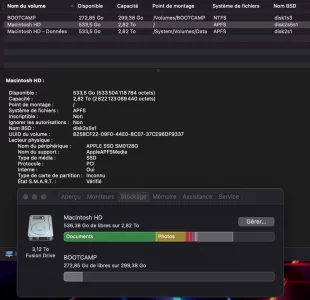Bonjour, sujet récurrent du forum manifestement : pépin bootcamp au niveau du partitionnement. Voici l'histoire :
Après avoir une première fois installé Win10 via Bootcamp (150Go alloué), j'ai décidé de faire machine arrière pour lui octroyer plus d'espace (genre 350, 400). Je retourne sous Mac, BootCamp assistant, suppression Windows (restaurer) : OK. Je récupére manifestement mon espace. (au total : 800 Go de libre sur mes 3To).
Seulement voilà, depuis lors, dès que je retente l'aventure, :
j'ai fait tous les check avec diskutil, tout est sain (en session et en recovery mode).
... HELP ??
Après avoir une première fois installé Win10 via Bootcamp (150Go alloué), j'ai décidé de faire machine arrière pour lui octroyer plus d'espace (genre 350, 400). Je retourne sous Mac, BootCamp assistant, suppression Windows (restaurer) : OK. Je récupére manifestement mon espace. (au total : 800 Go de libre sur mes 3To).
Seulement voilà, depuis lors, dès que je retente l'aventure, :
- au moment d'allouer l'espace pour la partition bootcamp, manifestement l'espace libre indiqué semble "oublier" que j'ai récupéré mes 150Go; seulement 650 de dispo d'indiqué.
- et de toute façon, durant le partitionnement, crash-reboot pur et simple de macos.
j'ai fait tous les check avec diskutil, tout est sain (en session et en recovery mode).
Bloc de code:
diskutil list
/dev/disk0 (internal, physical):
#: TYPE NAME SIZE IDENTIFIER
0: GUID_partition_scheme *121.3 GB disk0
1: EFI EFI 209.7 MB disk0s1
2: Apple_APFS Container disk2 121.1 GB disk0s2
/dev/disk1 (internal, physical):
#: TYPE NAME SIZE IDENTIFIER
0: GUID_partition_scheme *3.0 TB disk1
1: EFI EFI 209.7 MB disk1s1
2: Apple_APFS Container disk2 3.0 TB disk1s2
/dev/disk2 (synthesized):
#: TYPE NAME SIZE IDENTIFIER
0: APFS Container Scheme - +3.1 TB disk2
Physical Stores disk0s2, disk1s2
1: APFS Volume Macintosh HD - Données 2.3 TB disk2s1
2: APFS Volume Preboot 282.5 MB disk2s2
3: APFS Volume Recovery 652.6 MB disk2s3
4: APFS Volume VM 1.1 MB disk2s4
5: APFS Volume Macintosh HD 14.9 GB disk2s5
6: APFS Snapshot com.apple.os.update-... 14.9 GB disk2s5s1... HELP ??



